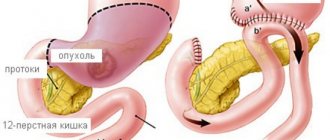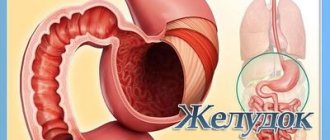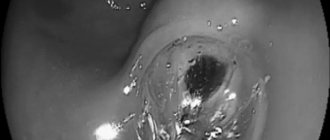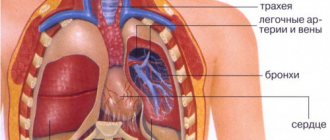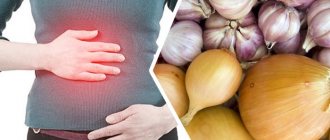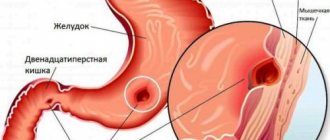Many people who care about their health try to lose weight. A correct lifestyle, which is directly related to health, can help them with this. It's no secret that in order to eat less you need to try to normalize the size of your stomach: a person's appetite and the amount of food he needs depends on the volume, condition and shape of the stomach.
In order to reduce the size of the stomach, obese people even undergo surgery. The size of the stomach is different for every adult and is constantly changing. The shape of this organ is also constantly subject to change. Why is this happening? This depends on many factors: on the amount of food consumed daily, on physiological characteristics, a history of stomach diseases, and even on the person’s physique.
How does the stomach work?
The stomach is the main one in the digestive chain.
The stomach is part of the digestive tract and is an organ made up of muscles. It is located in the upper third of the abdominal cavity and connects the esophagus and duodenum. An interesting fact is that the stomach can move when breathing. Its location directly depends on the fullness of neighboring organs. In a person who eats a small amount of food at one time, the stomach is located under the ribs. Main functions of the stomach:
- Chemical processing of food, the reagent of which is gastric juice. Gastric juice contains hydrochloric acid, chymosin, lipase and pepsin, which are digestive enzymes.
- Absorption of certain substances: water, sugar, salt.
- Synthesis of vitamin B12 to ensure iron absorption.
- Protecting the body from bacteria and microorganisms with the help of hydrochloric acid contained in gastric juice.
- The production of certain hormones and biologically active substances, including serotonin and histamine.
The main function of the stomach is to mix food with gastric juice and break down protein. All this is the beginning of a chain of a long process - digestion. In crushed and processed form, food is sent from the stomach to the duodenum. Gastric juice is a kind of reagent for food. It has neither color nor odor; up to two liters are produced per day. The amount of hormones produced by the stomach directly depends on the state of the chopped food. For example, more liquid food, bypassing processing, is immediately sent to the intestines, while coarse and solid food remains inside the stomach until it is completely processed.
The stomach has three sections: body, fundus and mucous membrane. The mucous membrane is a tissue consisting of three layers: its own, epithelial and muscle. The shell has folds, dimples and fields. The lining of the stomach is completely renewed every three days. This happens so that hydrochloric acid does not damage it. Its walls are protected by constantly produced mucus.
Anatomical structure
The stomach has two openings: the inlet - cardia or cardiac, and the outlet - pylorus or pylorus. They are both circular muscles called sphincters that open and close as needed. The cardia connects the esophagus to the stomach, regulates the flow of chyme and prevents reflux. The pylorus connects the organ with the duodenum.
The body of the stomach is its most powerful part, which is anatomically called the lesser and greater curvature. Its walls consist of different layers: mucous membrane, submucosal, muscle and serous tissue. Muscular – the one that helps form a bolus. The fundus of the stomach, its highest part, is located on the left under the diaphragm. This is where gases accumulate. And the antrum or antrum is a narrow area that is located in front of the pylorus.
The stomach is smooth on the outside, wrinkled on the inside. Its inner membrane has small pores, which are the openings of the glands. They secrete gastric juice - a liquid containing hydrochloric acid, pepsin, gastrin and lipase. All these compounds are necessary for the high-quality digestion of carbohydrates, proteins and fats, the absorption of nutrients from them and their absorption into the blood.
Lots of food - big belly!
The size of the stomach changes when food enters it.
When food enters the stomach, its size increases and the walls stretch. After the stomach has completed its function of processing food, it returns to its form. An empty stomach constantly moves, and at this time a person experiences a feeling of hunger. The shape of the stomach depends on the height and size of the person.
For example, in short and overweight people, the shape of the stomach resembles a horn. In tall and slender people, the shape of the stomach can be compared to a stocking. In people of standard build, the stomach is shaped like a hook. The size of the stomach can be easily adjusted. It depends on the amount of food a person consumes at one time. The walls of the stomach stretch and more and more food will be needed each time to become full (feeling of a full stomach). This can lead to an increase in the size of the stomach.
Healthy stomach size
The size of an adult's stomach when empty is no more than 500 ml; when full it can reach four liters. The average length of a healthy stomach is 25 cm, height is about 13 cm. The distance between the surfaces of the stomach (anterior and posterior) is about 8.5 cm. The distance between the lesser and greater curvature is 11 cm, in an empty stomach - 7.5 cm. In a hungry person The length of the stomach is 19 cm, while its walls touch each other.
Indications
Timely ultrasound examination will help maintain health and avoid various serious consequences. Ultrasound of the stomach is indicated not only for certain obvious pathologies, but also when a number of alarming symptoms appear:
- prolonged heartburn, nausea, vomiting, frequent belching;
- frequent pain of various types in the gastrointestinal tract;
- disturbance of the digestive process, loss of appetite, bloating;
- gastritis, ulcer;
- congenital anomalies of organ development;
- suspicion of cancer;
- polyps;
- pyloric stenosis, intestinal obstruction;
- suspicion of embryonic anomalies;
- severe discomfort in the abdominal area in a pregnant woman.
There are a number of separate indications for performing ultrasound of the stomach in children:
- frequent bronchitis;
- asthma;
- causeless increase in temperature;
- dry cough;
- excessive regurgitation in infants;
- abdominal pain;
- diarrhea, constipation, change in stool character;
- causeless nausea and vomiting.
Even healthy people are recommended to undergo an ultrasound of the stomach for preventive purposes. Moreover, all types of ultrasound can be done without a referral from a gastroenterologist or therapist, on your own initiative.
What disease is an enlarged stomach a symptom of?
An enlarged stomach is not only a harbinger of obesity, this indicator can be a symptom of other diseases. Such diseases include:
- Stenosis of the pylorus of the stomach. In which the size of the stomach increases, a sour taste is felt in the mouth, a constant feeling of a full stomach appears, and frequent vomiting.
- Malignant neoplasms in the stomach (cancer). Increased stomach volume, heaviness, blood in the stool, weakness, loss of appetite.
- Hernia in the area of the stomach and esophagus. Pain while eating and while moving.
- Gastric obstruction. Obstruction of food, retention in the stomach, formation of polyps or tumors.
- Hyperplastic gastropathy. During the disease, there is an increase in the folds of the gastric mucosa in size, due to which the stomach becomes larger. Patients experience delayed digestion, a feeling of bloating, pain and heaviness.
- Menetrier's disease. Multiple polyps in the stomach. The stomach is enlarged, frequent pain, weight loss, nausea, diarrhea, bleeding.
If any of these symptoms occur, you should undergo a full examination.
Vasilenko V.V. Stomach / www.GastroScan.ru
| Authors: Vasilenko V.V. |
Stomach
V.V.
Vasilenko Fig. 1. The Chinese character for stomach is not associated with this organ in any way.
The volume of an empty stomach is 50–60 ml. The capacity of the stomach, ranging from 1.5 to 2.5 liters, varies depending on the amount of food and liquid ingested. For those who love to eat, the stomach volume increases. While water and broth pass freely through the stomach, milk and beer are retained there.
It is therefore not surprising that some beer drinkers in Germany have a stomach that can hold up to 8 liters of liquid. The walls of the stomach secrete caustic substances that destroy food. Food is absorbed, however, not in the stomach, but in the small intestine. Serious accelerators, protein catalysts for the decomposition process of food are enzymes (from the Latin word “fermentation”), or enzymes (from the word “ferment”). The catalytic ability of enzymes is phenomenal.
Pepsinogen is formed in the stomach wall, which is converted into pepsin in the gastric contents (active only in an acidic environment). This enzyme breaks down proteins into simpler components that can be absorbed in the small intestine.
Digestive disorders associated with low and high (more than 0.5% hydrochloric acid) acidity of gastric juice are known. However, the most common disorders are the reservoir and motor functions of the stomach, the so-called lazy stomach.
Violation of the direction of peristaltic waves - antiperistalsis - causes nausea. The condition of the stomach also largely reflects the appearance of belching.
A fairly common functional digestive disorder is chronic idiopathic (i.e., unknown origin) nausea, which has a psychosomatic or, more precisely, psychosocial origin. It is not for nothing that such expressions as “sick of living” and “you make me sick” are popular. The severity of this condition may vary (Fig. 2).
Rice.
2. Assessment of the severity of nausea Medica mente non medicamentis.
— Treat with your mind, not with drugs. What should you do to eliminate or at least reduce this unpleasant feeling?
- First of all, change your lifestyle: if possible, reduce the workload and rest more often.
- Eat light food - often and little by little, limit your diet to spicy, fatty and fried foods.
- Avoid smells of perfume, food in the room, loud sounds, pressure of clothing on the stomach.
- During an attack, you should massage a point located three fingers above the wrist on the inner surface of the forearm.
Of the proven folk remedies, ginger (ground dried rhizome, sold as a spice) is good - 0.5 grams 4 times a day for 3 weeks.
It increases appetite, helps with digestive disorders with nausea and vomiting, and gas. Pharmacy preparations made from mint are also effective:
- peppermint oil - 15 drops 3-4 times a day, if there is no heartburn;
- infusion of leaves (it’s more convenient to brew filter bags and drink like tea);
- alcohol tincture in half with oil - 10-15 drops each;
- mint tablets - 1-2 pieces under the tongue during an attack.
If the above does not help, I recommend vitamin B (1 tablet 5 mg 4 times a day) plus antihistamines.
...Nature mercilessly mocks our ignorance... Anatole France
A frequent companion to nausea is lack of appetite. Appetite may decrease for many other reasons - both due to diseases of the digestive system and other diseases. In such cases, the following may help:
- bitter tincture (red centaury herbs and wormwood, water trefoil leaves, calamus rhizomes, coriander fruits, equally mixed with vodka); take 20–30 drops 2–4 times a day half an hour before meals with a small amount of water;
- tincture of wormwood;
- plantain tincture;
- equin - a solution of natural gastric juice;
- brewer's yeast, purified, dry (in granules); They are used not only internally, but also externally - as part of nourishing masks. In addition to increasing appetite, yeast improves intestinal motility and absorption capacity, pancreatic secretion, replenishes the deficiency of B vitamins, stimulates metabolism, strengthens hair and intensifies its growth, and improves the condition of problem skin.
A person suffering from a stomach disease must have his own psychology.
THEM. Sechenov Test “Can your stomach be called lazy?”
Answer a few questions.
- Do you feel heaviness in your stomach, especially after eating?
- Are you familiar with pain and discomfort in the epigastric region after eating?
- Do you experience early satiety or fullness while eating?
- Do you complain of bloating?
- Do you worry about nausea, especially after eating?
Check your results - add up your points. Each positive answer corresponds to 1 point, negative – 0.
- 0 points. You eat right, you are not at risk of dyspepsia.
- 1 point. You are not far from a healthy diet, but dyspeptic symptoms still make themselves felt. The diet needs some adjustment.
- 2–4 points. To get rid of dyspepsia, you need to radically reconsider your diet and diet.
- 5 points. You are probably eating poorly and have severe dyspepsia; You should not put off visiting a gastroenterologist for too long.
So, if according to the test results you are not “zero”, we can say: nothing dyspeptic is alien to you.
“As Galen reports, onions are not useful for choleric people. But for phlegmatic people, onions, he says, are a healing remedy. Best for the stomach; and the complexion is excellent.” "Salerno Code of Health", XIV century
.
What is dyspepsia?
Translated into Russian, the word “dyspepsia” means indigestion - in other words, a combination of disorders that are manifested by discomfort or pain in the upper abdomen, a feeling of early satiety, nausea, vomiting and bloating.
Dyspepsia, which is called functional dyspepsia, is common. The cause of its occurrence is disturbances in the motor function of the stomach. This is the same “lazy stomach syndrome”. It is known that for the normal absorption of food, the ability of the stomach to contract rhythmically and in a coordinated manner, crush food, process it and move it further. With dyspepsia, the organ becomes “lazy”. Food stays in it for a long time, which causes discomfort. During examination, gastric prolapse is often detected.
Every human head is like a stomach: one digests the food that enters it, and the other becomes clogged with it.
Kozma Prutkov Dyspepsia, or “lazy stomach”
The described symptoms are not always associated with food intake. If they are familiar to you, but no serious disease of the digestive tract (for example, ulcerative) has been detected, then you are susceptible to functional dyspepsia and have a “lazy stomach”.
Every third person on Earth is susceptible to such disorders to one degree or another. For some, manifestations of a “lazy stomach” are observed quite often - 1-2 times a week or more, for others - from time to time (usually after errors in diet or alcohol excess).
The causes and mechanisms contributing to the development of dyspepsia are still not well understood. Thus, in those suffering from dyspepsia, there was no excessive tendency towards alcoholic beverages, tea and coffee, or special adherence to medications. It is believed that smoking more than doubles the risk of dyspepsia.
The cause of heaviness in the stomach, bloating, and nausea can be either functional dyspepsia, banal overeating or neuropsychic stress reactions, as well as a number of other factors. The reason lies directly in the disruption of the motor activity of the stomach and duodenum.
How to minimize the risk of dyspepsia
To prevent exacerbations of the symptoms of a “lazy stomach”, it makes sense to follow the following recommendations:
- Chew your food thoroughly; take food in small portions and regularly - every day at the same time; then your stomach will be ready to eat;
- limit the consumption of animal fats (butter, fatty meats, etc.), carbonated drinks, coffee, chocolate;
- do not allow excess weight to appear;
- limit smoking and alcohol consumption;
- try to have your last meal no later than 2 hours before bedtime;
- If possible, avoid nervous tension and physical overload.
However, these rules are not a panacea at all, especially since, unfortunately, not everyone and not always can adhere to them in the modern world.
Wormwood has the first degree of warmth, and the strength is dry, It is reported that it is the second.
The one who takes it, no matter how he takes it, soon strengthens his stomach. However, the herb is better if you boil it with rainwater. And just before eating, you’ll cool it under the open sky. Odo from Mena “On the properties of herbs”, XI century. The collection is like this - the choice is yours
. What should you do if, while taking the “lazy stomach” test, you scored five points, although you follow the recommendations for preventing exacerbations of the symptoms of a “lazy stomach”? Before contacting a doctor, you can try over-the-counter remedies - depending on the severity of certain unpleasant sensations, using trial and error, select the appropriate ones and alternate them from time to time, or conduct a course of self-medication. Let's list the most effective ones.
- Aloe juice (1-2 teaspoons 2-3 times a day 30 minutes before meals) soothes the intestines and at the same time has a laxative effect.
- Drugs that enhance the secretion of bile by the liver and relieve spasms normalize stool: Flamin (a preparation from immortelle, tablets, 50 mg 3 times a day 30 minutes before meals; take during the course); olimethine (based on plant collection) in capsules; lyobil (ox bile); betaine citrate (effervescent tablets, dissolve in a glass of water, 1 piece 3 times a day).
- Gastric enzymes improve the breakdown of food and speed up gastric emptying: abomin (1-3 tablets 3 times a day for 1-3 months); acidin-pepsin (1 tablet of 0.25 grams during or after meals, 1-2 tablets 3-4 times a day); Pepsidil (1-2 tablespoons 3 times a day, preferably through a tube).
- Befungin (a drug made from birch mushroom, use according to instructions) increases stomach tone.
- Sub simplex reduces bloating (stronger than meteospasmil, espumizan, since the dose of the active substance in the tablet is higher).
Herbion gastric drops (plant extract, should be used according to instructions) reduce pain and indigestion.
Everything can be taken away from you, but not what you have already eaten. Bavarian Proverb
It's even better to do physical therapy and stop taking pills. For your health, master a special gymnastics complex of 12 exercises, designed to increase the tone of the stomach and anterior abdominal wall (Fig. 3).
Pancakes are not bad for your belly Proverb
Rice.
3. Gymnastics to increase the tone of the stomach and anterior abdominal wall. The effectiveness depends entirely on the regularity of exercise (preferably at least 2-3 times a week). Perform exercises 2 hours before your main meal or in the morning. The duration of the lesson is 30–40 minutes. Add musical accompaniment as an emotional component. It’s great if you go for a walk 1-2 hours after eating.
- Starting position - lying on your back, legs straight, arms along the body. Bend your knees one at a time. Breathing is free. The pace is average. Repeat 4-6 times with each leg.
- The starting position is the same. Raise your straight legs one at a time. Breathing is free. The pace is average. Repeat 4-6 times with each leg.
- The starting position is the same. As you exhale, sit up from a lying position. At first, you can help yourself with your hands. As you inhale, return to the starting position. The pace is slow and smooth. Repeat 3-4 times. After 1–2 weeks of training, in the absence of pain and other unpleasant sensations, exercises 1–3 can be complicated: exercises 1 and 2 can be performed simultaneously with both legs; When performing exercise 3, place your hands on the back of your head.
- The starting position is the same. Hands under your head. Sliding your heels along the floor, pull your feet as close to your buttocks as possible, spread your knees to the sides, trying to reach the floor. Then bring your knees together and straighten your legs, sliding your feet along the floor again. Don't hold your breath. The pace is slow. Repeat 3-4 times.
- The starting position is knee-elbow. As you exhale, slowly straighten your knees, resting on your toes and forearms. As you inhale, return to the starting position. The pace is slow. Repeat 2-4 times.
- The starting position is the same. Feet width apart. As you move your knees along the floor, pull them towards your elbows, while rounding your back. Then return to the starting position. The pace is average. Repeat 4-8 times.
- Starting position - sitting on a stool, legs straight, hands on knees. As you inhale, spread your arms to the sides, as you exhale, bend forward, trying to reach the floor. Repeat 2-4 times.
- The starting position is the same. Hands on the belt. As you inhale, lean forward, as you exhale, lean back. The pace is slow and smooth. Repeat 2-4 times.
- Starting position: standing, feet hip-width apart, hands on the waist. As you inhale, bend forward, and as you exhale, return to the starting position. The pace is average. Repeat 4-6 times.
- The starting position is the same. Tilt your body to the sides. The pace is average. Repeat 4-6 times in each direction.
- The starting position is the same. Hands to the side. As you exhale, tilt your body forward, moving your right arm back, and with your left trying to reach the toe of your right foot; while inhaling, return to the starting position. Then perform a tilt by changing the position of your hands. The pace is average. Repeat 2-4 times.
- The starting position is the same. Hands in front of chest. As you exhale, spread your arms to the sides and turn your body to the left. As you inhale, return to the starting position. Perform the same movement by turning your body to the right. The pace is average. Repeat 2-4 times on each side.
Do not be a wise man in your own eyes; Fear the Lord and shun evil: this will be health for your body and nourishment for your bones. Prov. 3:8
V.V. Vasilenko. Sixty essays on digestion (recommendations from a gastroenterologist to patients) Back to section
How is the size of the stomach determined?
Fluoroscopy can be used to determine the size of the stomach.
To diagnose an enlarged stomach in modern medicine, the following diagnostic methods are used:
- X-ray
- Gastroscopy
- Computer diagnostics
To determine the size of the stomach using fluoroscopy, the patient is given a special liquid to drink. Then the specialist uses X-rays to obtain an image of the organ on a fluorescent screen. Today, X-ray television examination is used, during which the resulting image can be further processed in order to better diagnose the disease. The image remains in the device's memory and on the film.
Gastroscopy is performed to examine the inner surface of the stomach and its mucous membrane. A tube with a camera is inserted through the throat and esophagus into the patient's stomach. The image from the camera appears on the monitor. If necessary, the image is recorded. During the procedure, it is possible to conduct additional diagnostics: taking tissue for a biopsy. Computed tomography of the stomach has a number of advantages compared to other diagnostic methods:
- No special liquid is used during the study.
- Provides a more complete image in several projections compared to radiography.
- Does not cause pain during the procedure, compared to gastroscopy.
Accurate diagnosis
Identification of provoking factors that cause stomach pain always begins with a questioning of the patient and a physical examination - palpation of the abdomen, listening to the heart rhythm and lungs. After this, laboratory tests are carried out:
- Blood test (general and biochemical).
- Study of biomaterial (stool, urine and gastric juice).
To clarify the diagnosis, instrumental tests are also necessary - endoscopy, ultrasound, X-ray, computed tomography or magnetic resonance imaging of the abdominal organs with a contrast agent. In extremely rare cases, it may be necessary to conduct an examination using a laparoscope. When a flexible probe with a microcamera is inserted into the organ through a small incision for a detailed study and assessment of the general condition.
The location of the stomach explains the diversity of the nature of pain and such an extensive list of pathologies that cause them. Therefore, such a symptom should never be neglected. If you experience discomfort in the epigastrium, you must always seek medical help. Timely treatment in many cases guarantees recovery.
How to prepare for the procedure
Compliance with all recommendations regarding preparation for an ultrasound examination of the stomach will give the most accurate and high-quality result. Preparation is carried out in several stages and consists of the following:
- 2-3 days before the procedure
. A diet aimed at reducing gas formation in the stomach and intestines is required. To do this, avoid drinking carbonated drinks, fresh vegetables and fruits, herbs, legumes, sweets, dairy and yeast products, rye bread, fresh juice, black tea and coffee. Also avoid alcohol and smoking. It is recommended to form your diet from boiled meat, fish, cottage cheese, soft-boiled eggs and porridge cooked in water. If necessary, you need to take enzymes that improve the digestion process (mezim, festal, etc.). A day before the procedure, it is necessary to cleanse the body with the help of sorbents (activated carbon, smecta, etc.), and for people suffering from stool disorders, with the help of laxatives. - On the eve of the procedure
. The study is carried out strictly on an empty stomach. As a rule, it is prescribed in the morning, so the last meal should be a light dinner 10-12 hours before the ultrasound. For children, fasting should last 6-8 hours, and for infants 3-3.5 hours, while their stomach is examined immediately after feeding. - Before the procedure
. Skip breakfast and drinks. It is not recommended to even brush your teeth, as there is a possibility of toothpaste getting into your stomach.
Interpretation of ultrasound of the stomach: normal parameters of the organ
A qualified specialist, knowing the normal indicators, can simply determine pathological changes in the stomach. Normally, sections of an organ have a round or oval shape - in the form of a ring with an echo-positive central part and an echo-negative rim. The walls of the stomach are uniform and consist of 5 layers. The removal of a glass of liquid from the stomach occurs in approximately 20 minutes, and the primary withdrawal of liquid is normally about 3 minutes.
Normal values for the thickness of parts of the stomach
| Stomach in the pyloric region | up to 8 mm |
| Stomach in the proximal zone | up to 6 mm |
| Muscle layer | 2 – 2.5 mm |
| Slime layer | up to 1.5 mm |
| Submucosa | up to 3 mm |
| Lamina mucosa | up to 1 mm |
Normal echogenicity values
| Outer serous membrane | high |
| Muscle layer | low |
| Slime layer | high |
| Submucosa | average |
| Lamina mucosa | low |
| Stomach wall | varying degrees of echogenicity of the layers |
Interpretation of pathological indicators visible on ultrasound
| Pathology | Signs on ultrasound |
| Impaired gastric emptying | maximum distension of the stomach with liquid; lack of peristalsis (not always); internal echostructure may vary from anechoic to hyperechoic |
| Swelling of the wall | the thickness of the stomach wall exceeds 7 mm; homogeneous wall structure; hypoechogenicity, uniform thickening |
| Diffuse neoplastic wall thickening | the walls of the stomach are hard, inelastic, with low echogenicity; boundaries between layers are not detected; there are no organ contractions |
| Aberrant tumor vessels | a thickened wall with low echogenicity is detected due to the penetration and accumulation of tumor particles in it |
| Lack of differentiation of the wall into normal layers | the lumen in the stomach is significantly narrowed due to obliteration |
| Congenital hypertrophic pyloric stenosis | thickening of the pyloric muscle ring; slow removal of contents from the stomach; increasing organ mobility and antiperistalsis |
| Acquired pyloric stenosis | frigidity of the pyloric wall; anechoic structure, homogeneous pinpoint echo structure, or coarse internal echoes |
| Varicose veins of the stomach | the outer wall of the stomach is anechoic or cystic thickened in some areas; blood flow from the liver and portal-systemic blood flow were identified |
| Peptic ulcer | the stomach wall is thickened; crater-shaped depressions are visible on the inner surface |
| Benign tumor | formation of a round shape; has smooth edges and low echogenicity; no metastases |
| Malignant tumor | the wall of the stomach is thickened unevenly (round or lobed); the gastric outlet is narrowed; the layers of the stomach are blurred, the contours are uneven |
| Carcinoma | polypoid: lobular formation; circular: a round or oval-shaped formation with an echogenic center, inside of which there is air and mucus. Possible detection of metastases |
| Malignant lymphoma | appears similar to diffuse lymphoma or carcinoma |
| Mesenchymal tumor | benign: no more than 6 cm, vessels are not identified; malignant: more than 6 cm, tumor vessels, possible metastases |
| Cystic formations | formations of 2 layers: echogenic internal mucous and hypoechoic muscular external |
Mechanical restoration
The walls of the stomach contract, which allows food to be crushed and gradually moved to the outlet into the intestines, in which other chemical elements continue to break down nutrients, absorb water and extract all the necessary beneficial elements from food.
Each of the stages is closely related to the others, so disruption of one of the processes inevitably entails consequences in the form of episodic or permanent digestive problems.
The most obvious manifestations are violations of motor functions - the movement of food into the intestines. With insufficient or chaotic contraction of the stomach walls, nausea, belching and other unpleasant symptoms develop. Episodic cases of motor impairment may be associated with overeating, the presence of a large number of “heavy” dishes on the menu - fried, fatty. If you have persistent or regular symptoms of indigestion, you should reconsider your entire lifestyle and even consult a doctor.
